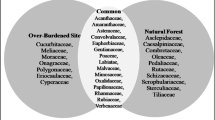Abstract
Mammalian communities were studied on 10 surface mines over a four year period. The size and composition of these communities varied among the different areas. The size, composition, and spatial distribution of these mammalian communities were related to the structure of the plant community, and native plant species were of greater importance in determining size and composition of these communities than were those used in reclamation.
Similar content being viewed by others
Literature cited
Brenner, F. J. 1973. Evaluation of abandoned strip mines as fish and wildlife habitats.Trans. N.E. Wildlife Conf. 30:205–229.
Brenner, F. J. 1974. Ecology and productivity of strip mine areas in Mercer County, Pennsylvania. Research Technical Completion Report. A-029-PA. Institute for Research on Land and Water Resources. The Pennsylvania State University, University Park, PA. 70 pp.
Brenner, F. J. 1978a. Evaluation of factors promoting the preservation of aquatic ecosystems in reclaimed strip mine areas. Research Technical Completion Report. A-044-PA. Institute for Research on Land and Water Resources. The Pennsylvania State University, University Park, PA. 62 pp.
Brenner, F. J. 1978b. Food and cover evaluation of strip mine plants as related to wildlife management. Pages 294–305m D. E. Sammel, J. R. Stauffer, C. H. Harcott, and W. T. Mason (eds.) Proceed. Symposium Surface Mining and Fish/Wildlife Needs in the eastern United States. OBS/FWS. 386 pp.
Brenner, F. J., R. H. Crowley, M. J. Musaus, and J. H. Goth, III. 1975. Evaluation and recommendations of strip mine reclamation procedures for maximum sediment erosion control and wildlife potential. 3rd Symposium on Surface Mining and Reclamation.11:2–23.
Brenner, F. J., M. J. Musaus, and W. Granger. 1977. Selectivity of browse species by white-tailed deer on strip-mined lands in Mercer County, Pennsylvania.Proc. Pa. Acad. Sci. 51:105–108.
Cashwiler, J. S. 1970. Plant and mammal changes on a clearcut in west-central Oregon.Ecology. 51:1018–1026.
Christian, J. J. 1978. Neurobehavioral endocrine regulation of small mammal populations. Pages 143–158in D. Snyder (ed.), Populations of small mammals under natural conditions. Vol. 5. Special Publ. Series. Pymatuning Laboratory of Ecology. University of Pittsburgh, Pittsburgh, PA. 237 pp.
Davies, R. G. 1971. Computer programming in quantitative biology. Academic Press. NY. 402 pp.
Davis, D. E. 1978, Physiological and behavioral responses to the social environments. Pages 84–93in D. P. Snyder (ed.), Populations of small mammals under natural conditions. Vol. 5. Special Publ. Series. Pymatuning Laboratory of Ecology. University of Pittsburgh. 237 pp.
DeCapita, M. E., and T. A. Bookhout. 1975. Small mammal populations, vegetational cover and hunting use of an Ohio strip mine area.Ohio J. Sci. 75:305–323.
Grant, P. R. 1978. Competition between species of small mammals. Pages 38–51in D. P. Snyder (ed.), Populations of small mammals under natural conditions. Vol. 5. Special Publ. Series. Pymatuning Laboratory of Ecology. University of Pittsburgh. 237 pp.
Grice, D. G., R. S. Grubb, and C. A. Jaquish. 1971. Soil survey of Mercer County, Pennsylvania. U.S. Government Printing Office, Washington, DC. 95 pp.
Hansen, L. P. and J. E. Warnock. 1979. Response of two species ofPeromyscus to vegetational succession on land strip mined for coal.Am. Midl. Nat. 100:416–423.
Hayne, D. W. 1949. Two methods for estimating populations from trapping records.J. Mammal. 30:399–411.
Kirkland, G. L., Jr. 1974. Preliminary sampling of small mammals on clearcut and uncut red spruce stands in West Virginia.Proc. West Virginia Acad. Sci. 46:150–154.
Kirkland, G. L., Jr. 1977. Responses of small mammals to the clearcutting of northern appalachian forests.J. Mammal. 58:600–609.
Klimstra, W. D., P. A. Vohns, and J. D. Cherry. 1963. Strip-mine lands for recreation.Illinois Wildlife 13:1–6.
Krull, J. N. 1970. Small mammal populations in cut and uncut northern hardwood forests.New York Fish and Game Comm. J. 17:128–130.
Lidicker, W. Z., Jr. 1978. Regulation of numbers in small mammal populations — historical reflections and a synthesis. Pages 122–142in D. P. Snyder (ed.), Populations of small mammals under natural conditions. Vol. 5. Special Publ. Series. Pymatuning Laboratory of Ecology. University of Pittsburgh, University Park, PA. 237 pp.
Lovejoy, D. A. 1971. The effect of logging on small mammal populations on the White Mountain National Forest of New Hampshire. Unpub. Ph.D. Diss. Univ. Connecticut, Storrs, CT. 164 pp.
M'Closkey, R. T. 1975. Habitat succession and rodent distribution.J. Mammal. 56:950–955.
MacArthur, R. H., and J. W. MacArthur. 1961. On bird species diversity.Ecology 42:594–598.
McGregor, R. C. 1958. Small mammal studies on a southeast Alaska cutover areas. U.S. For. Serv., Alaska For Res. Center. Research Paper. 8:1–9.
Moore, A. W. 1942. Shrews as a check on Douglas fur regeneration.J. Mammal. 23:37–41.
Radvanyl, A. 1970. Small mammals and regeneration of white spruce forests in western Alberta.Ecology. 51:1102–1105.
Riley, C. V. 1954. The utilization of reclaimed coal striplands for the production of wildlife.Trans. N. Amer. Wildl. and Nat. Res. Conf. 19:324–337.
Siegel, S. 1956. Nonparametric Statistics for Behavioral Sciences. McGraw-Hill, NY. 312 pp.
Simpson, G. G., A. Roe, and R. C. Lewontin. 1960. Quantitative Zoology. Harcourt Brace, NY. 440 pp.
Snedecor, G. W. 1956. Statistical Methods. Iowa State College Press. Ames, IA. 534 pp.
Trevis, L. P. 1956. Responses of small mammal populations to logging of Douglas fur.J. Mammal. 37:189–196.
Trousdell, K. B. 1954. Peak population of seed-eating rodents and shrews occurring 1 year after loblolly stands and cut.Southeastern For. Res. Stat. Research Notes. 68:1–2.
Tyron, G. A., and D. P. Snyder. 1973. Biology of the eastern chipmunk,Tamias striatus: life tables, age distribution and trends in population numbers.J. Mammal. 54:145–168.
U.S. Fish and Wildlife Service. 1980. Habitat evaluation procedures (HEP) ESM 102. Washington, DC.
Zippen, C. 1958. The removal method of population estimationJ. Wildl. Mgmt. 22:325–339.
Author information
Authors and Affiliations
Rights and permissions
About this article
Cite this article
Brenner, F.J., Kelly, R.B. & Kelly, J. Mammalian community characteristics on surface mine lands in Pennsylvania. Environmental Management 6, 241–249 (1982). https://doi.org/10.1007/BF01866887
Issue Date:
DOI: https://doi.org/10.1007/BF01866887




